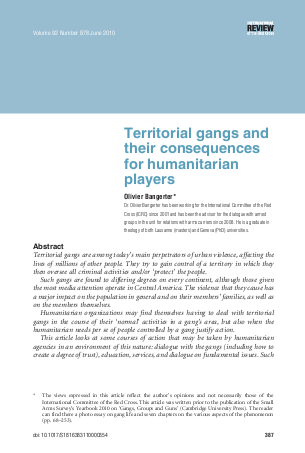
Territorial gangs are among today’s main perpetrators of urban violence, affecting the lives of millions of other people. They try to gain control of a territory in which they then oversee all criminal activities and/or ‘protect’ the people. Such gangs are found to differing degrees on every continent, although those given the most media attention operate in Central America. The violence that they cause has a major impact on the population in general and on their members’ families, as well as on the members themselves. Humanitarian organizations may find themselves having to deal with territorial gangs in the course of their ‘normal’ activities in a gang’s area, but also when the humanitarian needs per se of people controlled by a gang justify action. This article looks at some courses of action that may be taken by humanitarian agencies in an environment of this nature: dialogue with the gangs (including how to create a degree of trust), education, services, and dialogue on fundamental issues. Such action only makes sense over the medium to long term; it may have a very positive impact but only allows the symptoms of a deep-seated problem to be treated.
Resource collections
- UN Habitat - Urban Response Collection
- Urban Response - Urban Crisis Preparedness and Risk Reduction
- Urban Response Collection - Community Engagement and Social Cohesion
- Urban Response Collection - Economic Recovery
- Urban Response Collection - Environment and Climate Change
- Urban Response Collection - Housing, Land and Property
- Urban Response Collection - Urban Crisis Response, Recovery and Reconstruction
- Urban Response Collection - Urban Resilience